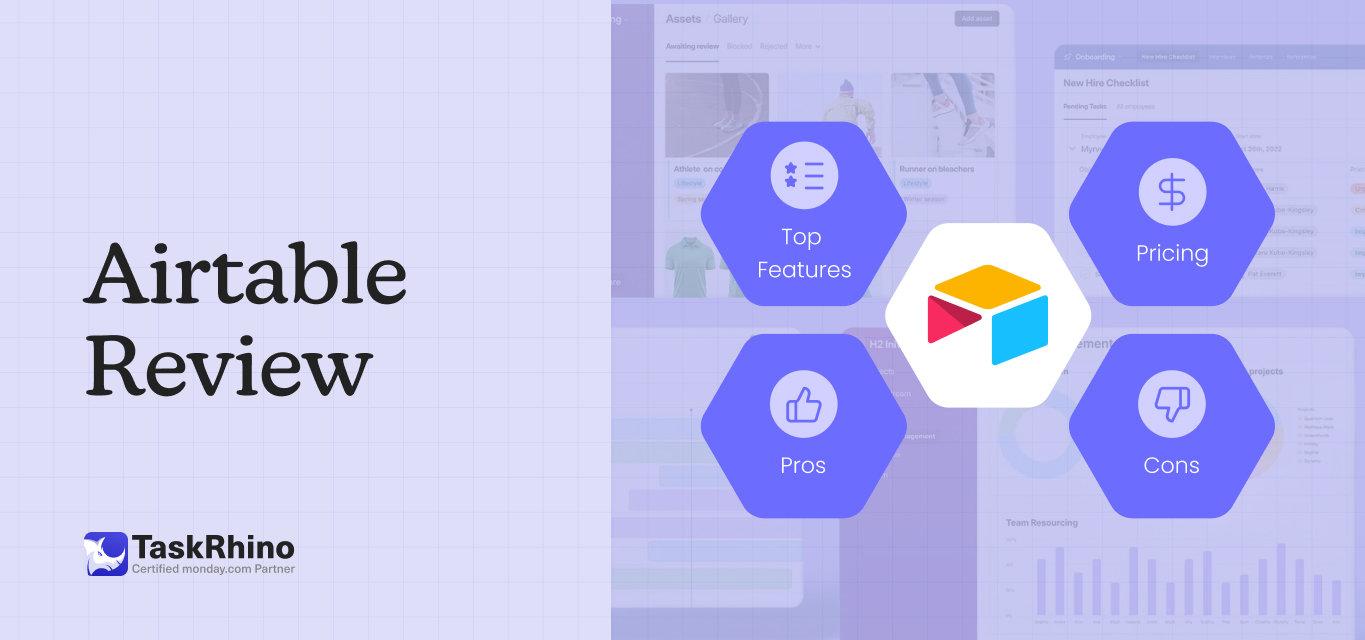
Airtable Review 2025: Comprehensive Features, Pricing & Analysis
Summary: This Airtable review covers its features, pros, cons, and pricing. We explore how Airtable offers flexible project management, handles integrations and supports large teams. Plus, we’ll explore how to get started with an Airtable.
Finding the right project management tool is like searching for the perfect match—it must fit your team’s unique needs and style. Airtable, blending the familiarity of spreadsheets with robust database capabilities, presents a unique solution for organizing and managing projects.
But does it live up to the promise? 🤔
Can Airtable deliver where other platforms fall short?
Let’s break it down. This blog will explore Airtable’s features, highlight its benefits and potential drawbacks, and determine if it could boost your team’s productivity.
Let’s scout in and see if Airtable is the tool you’ve been looking for!
What is Airtable?
Airtable is a flexible solution that combines the best elements of spreadsheets and databases. It’s designed to help you quickly manage projects and track project progress.
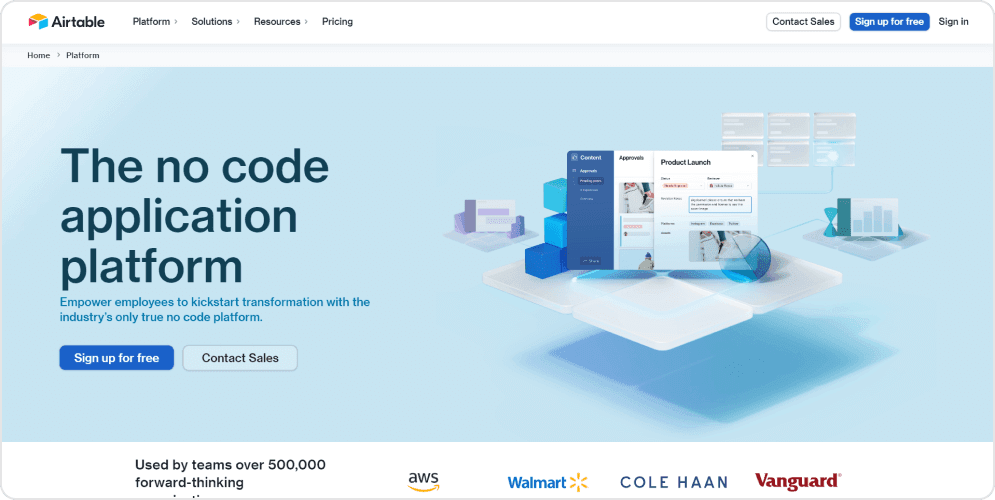
While Airtable shines in providing customizable bases and premium features for team collaboration, it’s not always the right tool for every scenario. It supports various integrations and extensions, but you might need to explore Airtable alternatives if you require specific features like detailed time tracking or enterprise-scale plans.
The platform’s free plan offers a relatively generous range of features, including unlimited bases and access to basic templates.
However, you’ll need to look into paid plans for more advanced needs, such as premium sync integrations or additional storage space.
Airtable’s vast help center and interface designer tools make it easy to start, but choosing between Airtable and other tools depends on your specific requirements.
Whether you’re organizing a content calendar or tracking complex project data, Airtable’s versatility is hard to ignore.
But to truly understand how it measures up, let’s start with a quick comparison table against monday.com. This will give you a clearer picture of where Airtable stands before diving into the detailed review.
Airtable Review – Quick Comparison with monday.com
| Features | Airtable | monday.com |
|---|---|---|
| Project Management Tools | Database-driven, flexible solution | Visual task management with multiple views |
| Team Collaboration | Strong real-time collaboration | Customizable team workflows |
| Gantt Charts | Available with Airtable extensions | Built-in with advanced features |
| Timeline Views | Available via paid plans | Integrated into all plans |
| Kanban Boards | Included in the free plan | One of the most popular Views |
| Storage Space | Limited on free plan, more in paid | Scalable storage for enterprise plans |
| Help Center & Support | Detailed help center | Extensive help center & live support |
| Free Plan | Fairly generous with unlimited bases | Offers free plan with basic features |
| Try monday.com |
For a deeper exploration into how Airtable stacks up against monday.com, including a detailed look at their features and strengths, check out our complete comparison here: Airtable vs monday: Best Project Management Tool Comparison.
Getting Started With Airtable Account:
Getting started with Airtable is simple and user-friendly. Sign up for an account on the company’s website.
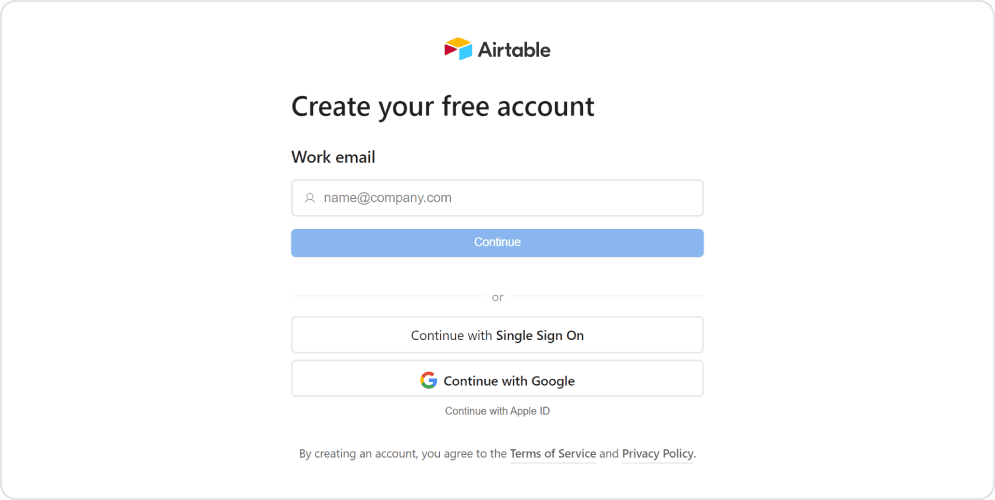
After registering, you’ll encounter an intuitive interface for effective project management and team collaboration.
You can start from scratch, use pre-built templates, or import data from other sources like Google Sheets to create your first base. Each base functions as a flexible database, allowing you to manage project data, track progress, and store records in a way that fits your needs.
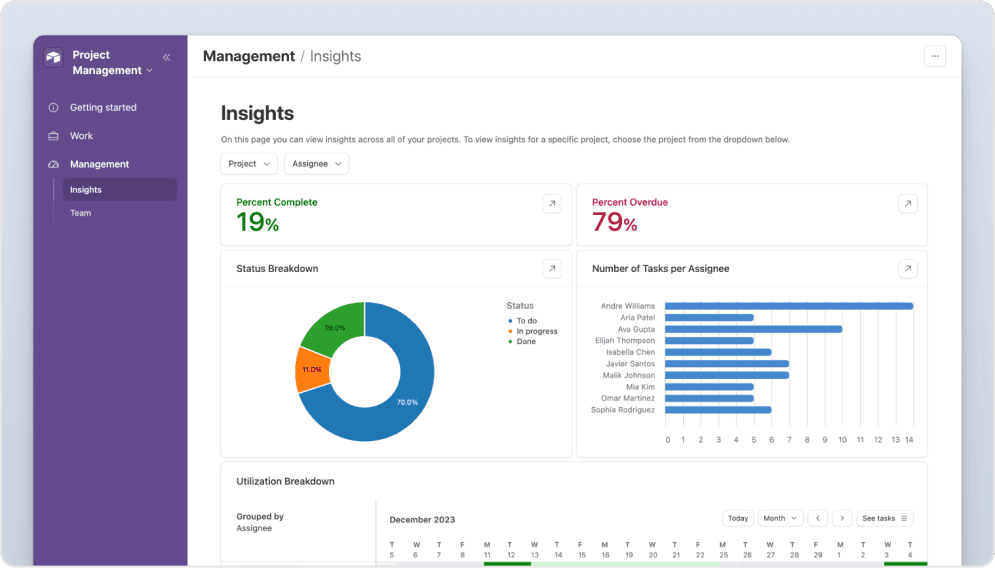
Airtable’s system supports multiple views, including Grid, Kanban boards, Calendar, and Timeline views. These features help you visualize and organize your data efficiently. The drag-and-drop interface designer allows for easy customization of tables and fields, enhancing your ability to manage projects effectively.
However, it’s worth noting that some advanced features, like Gantt charts, are not included by default and require users to add them manually through Airtable’s marketplace or extensions.
This could mean additional setup time for those looking to utilize Gantt charts for detailed project planning.
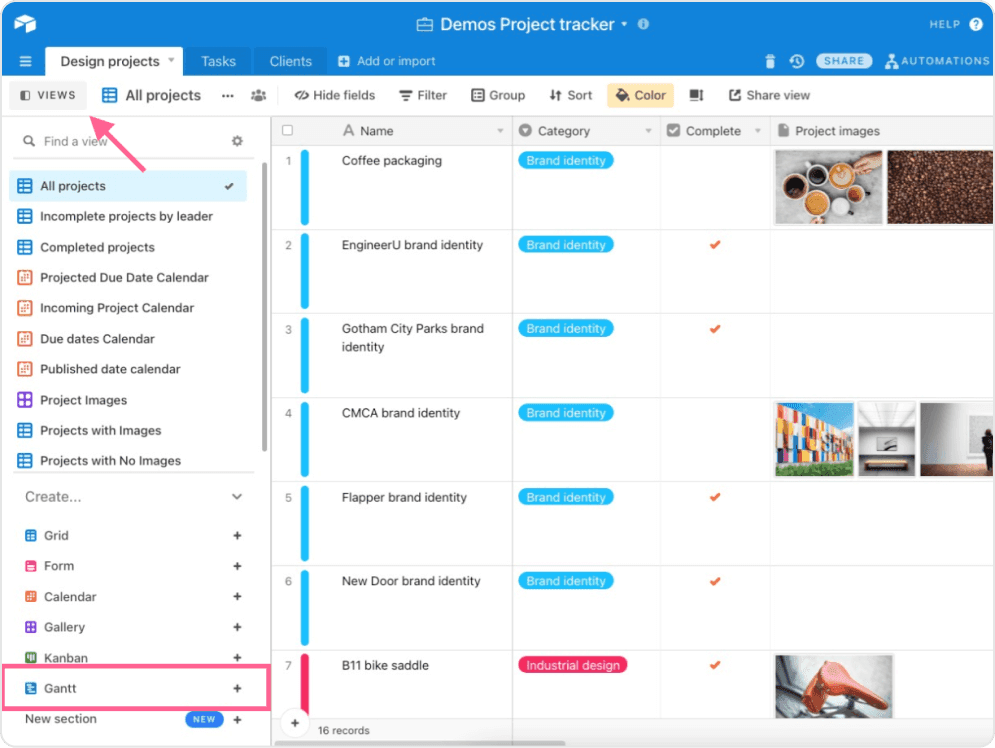
Airtable offers real-time updates for team collaboration and integrates with other tools and apps, such as Slack and Google Drive. Premium sync integrations and advanced features like time tracking further enhance its utility for small and large teams.
Overall, Airtable offers a straightforward setup process that integrates well with various tools and provides a flexible environment for managing projects and team collaboration. With its intuitive interface and customizable bases, you’ll quickly find the proper configuration to meet your needs.
While some advanced features require additional setup, Airtable’s core functionalities make it a powerful tool for individual and team use.
Expert monday.com Consulting Services
Guiding Your monday.com Journey from implementation, training, support, and more…
Airtable Core Features:
To comprehensively analyze what Airtable offers, it’s essential to understand its core features. Let’s get a breakdown of the most common yet – essential features:
1. Ease of Use
Airtable excels in ease of use, making it appealing for beginners and experienced project managers. Its intuitive interface is designed for easy navigation, offering a clean dashboard where users can manage bases and tables without a steep learning curve.
One often overlooked feature is how Airtable balances simplicity and complexity. While user-friendly for beginners, its customizable field types—like attachments, checkboxes, and formulas—allow advanced users to tailor project data to their needs.
The drag-and-drop functionality enables easy record reorganization and customization of views like Grid, Kanban boards, and Calendar, making project management smooth. Airtable also offers a variety of templates for different use cases, which speeds up the setup process and lets users start managing projects quickly.
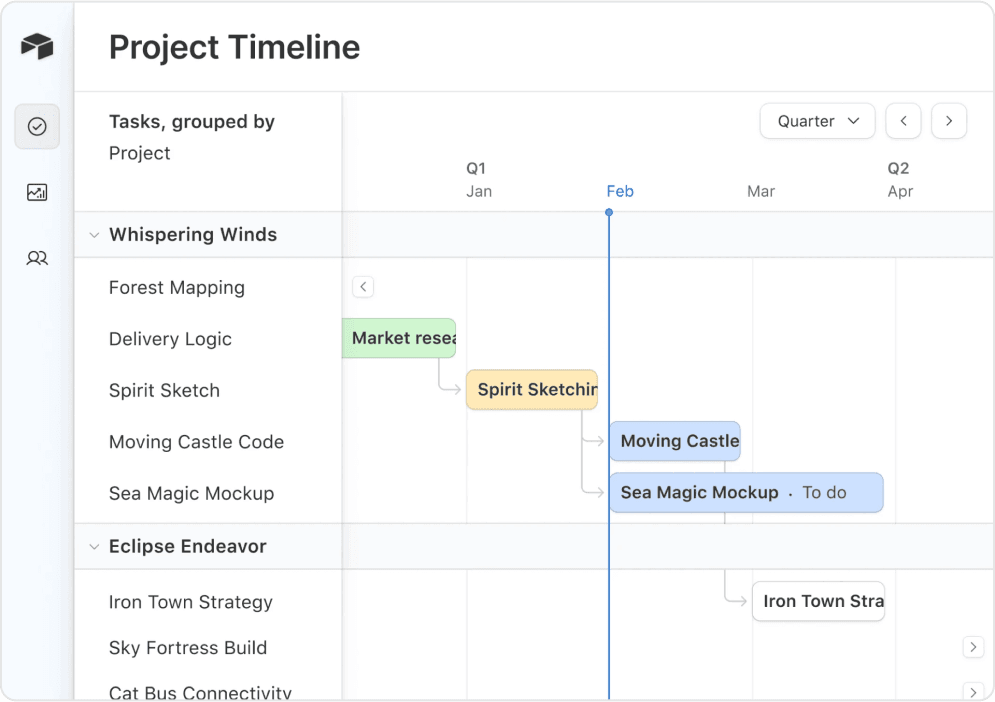
Many users miss how well Airtable scales as projects or teams grow. It retains its ease of use even for large organizations managing expansive project data without performance issues. Another hidden gem is the platform’s real-time flexibility—users can adjust views, apply filters, and link tables on the go without disrupting workflows.
With a robust help center and support resources, Airtable ensures users can focus on their projects without worrying about complex setups. This flexibility and adaptability make it a highly versatile tool for managing small tasks to enterprise-level projects.
2. Automation
Airtable’s automation capabilities are designed to streamline repetitive tasks, saving time and boosting productivity. Users can use automated workflows to trigger actions based on conditions, such as sending emails, updating records, or creating tasks. This highly customizable feature enables users to automate processes independently without advanced technical skills.
With pre-built automation templates and an easy-to-use interface, setting up automation is straightforward, making it accessible for beginners and advanced users.
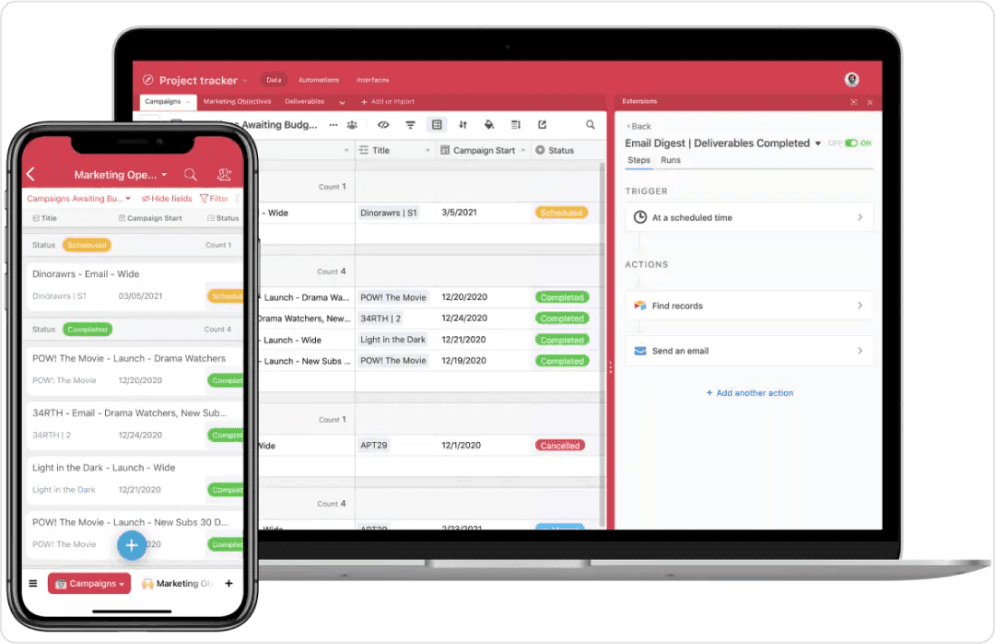
For those needing more complex workflows, Airtable allows users to extend the functionality of their automation with custom logic using Javascript.
Whether integrating with external tools through premium sync integrations or adding personalized workflows, Airtable can seamlessly automate both simple and complex processes.
However, a common oversight in discussions about Airtable automation is the potential for over-reliance. Automating too many tasks can lead to unintended consequences, such as losing control over manual processes or missing critical details.
While automation is a powerful feature, balancing is essential to maintain oversight on key tasks. Over-automation can complicate workflows, especially for teams that prefer a more hands-on approach.
3. Integrations
One of Airtable’s most remarkable traits is its extensive integration capabilities, which allow users to effortlessly connect their workflows with various external tools. Whether you’re using communication platforms like Slack or managing files with Google Drive, Airtable supports advanced syncing options that keep data updated across multiple applications.
Moreover, Airtable integrates smoothly with popular project management tools like Trello, Jira, and Asana, enabling users to link their projects and manage workflows across platforms.
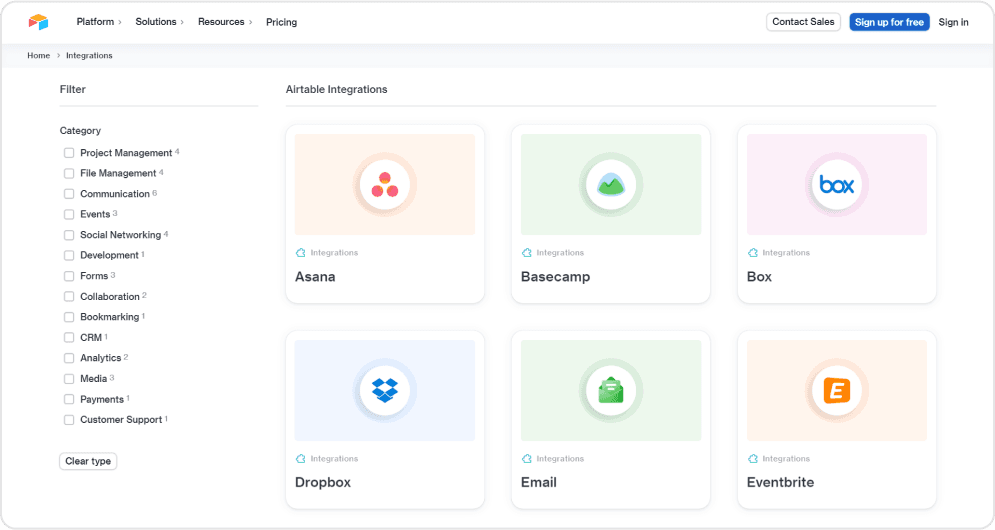
The connection with Google Sheets is especially helpful for those handling large datasets, allowing easy migration without losing key spreadsheet functionalities. For teams with more customization needs, Airtable’s API provides the flexibility to create custom integrations, making it possible to connect with almost any service.
One aspect often overlooked is the potential complexity of managing too many integrations. While they offer great flexibility, excessive reliance on external platforms can lead to challenges, such as disjointed workflows or data inconsistency if one connected tool experiences issues. To avoid these pitfalls, it’s important to integrate thoughtfully and keep your setup smoothly.
By linking Airtable to other platforms, users can improve efficiency and create a more integrated and cohesive project management experience.
4. Security
Airtable strongly emphasizes security, ensuring that your data is protected; nevertheless, you’re a small business or operating at an enterprise scale. The platform offers a range of security measures, including data encryption, both at rest and in transit, safeguarding sensitive information from unauthorized access.
For larger organizations, Airtable provides additional layers of protection through features like Single Sign-On (SSO) and two-factor authentication (2FA), making it easier to enforce strict access controls and minimize potential security risks.
Airtable also complies with various industry standards and regulations, such as SOC 2 Type II and GDPR, ensuring it meets the required compliance benchmarks for securely handling data.
A commonly overlooked aspect of Airtable’s security is the control over user access within a single base. Admins can set granular permissions, ensuring team members only have access to the necessary information.
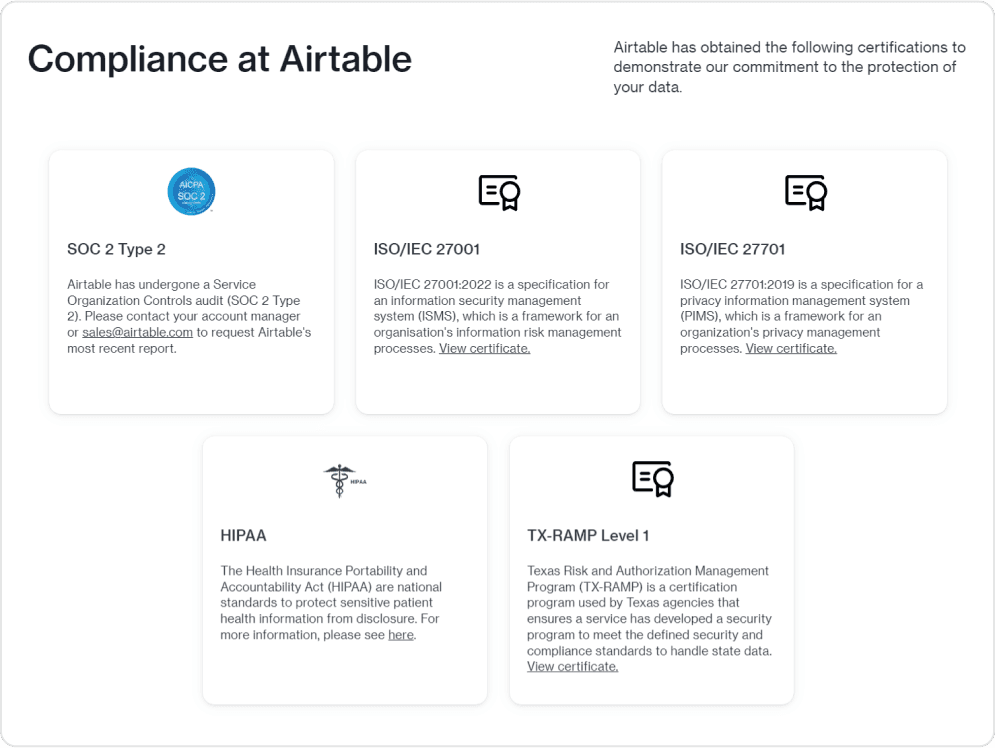
However, some users may find the role-based access control (RBAC) somewhat limited, especially compared to more specialized security-focused platforms.
While Airtable offers solid security features, it’s important to note that advanced security configurations, such as custom permissions or more in-depth auditing tools, are typically only available in higher-tier plans.
5. Pricing
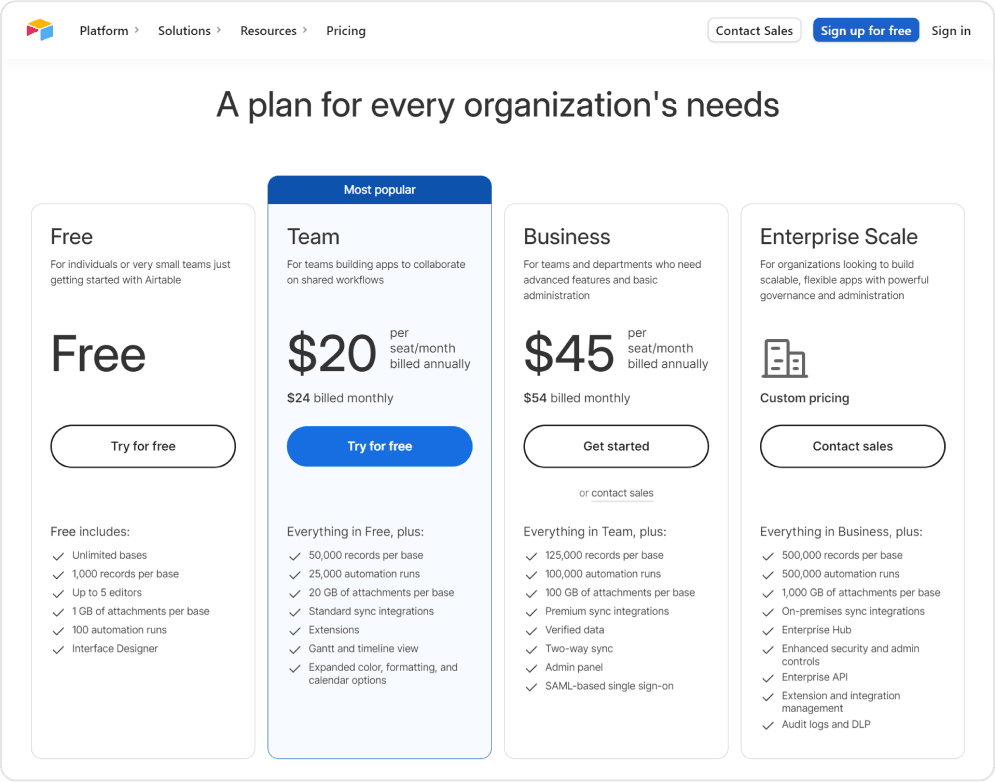
Free Plan:
- It is ideal for individuals or small teams starting with Airtable.
- Includes unlimited bases, 1,200 records per base, and up to 2GB of attachment space.
- More advanced features but sufficient for basic project management needs.
Plus Plan ($12 per user/month, billed annually):
- Great for growing teams needing more storage and records per base.
- Increases limits to 5,000 records per base and 5GB of attachments.
- Offers additional customization options and more advanced features like snapshot history.
Pro Plan ($24 per user/month, billed annually):
- It is best for teams requiring advanced capabilities.
- Includes up to 50,000 records per base, 20GB of attachments, and enhanced features like Gantt charts, timeline views, and advanced sync options.
- Access to Interface Designer and other premium features for building customized workflows.
Enterprise Plan (custom pricing):
- Custom-made for large organizations that need enterprise-level features.
- Offers enhanced security, priority support, premium sync integrations, unlimited records, and custom permissions.
- Direct contact with the sales team is required for pricing based on specific requirements.
6. Customer Service
Airtable offers a range of customer service options, ensuring that users can find support when needed:
- Help Center: Comprehensive self-service support with articles, tutorials, and guides covering various topics. It’s well-suited for users who prefer to troubleshoot independently.
- Email Support: This service is available for all users, but response times can vary depending on the plan. Free users may experience slower response times compared to paid plans.
- Priority Support: Offered to Pro and Enterprise plan users, ensuring faster response times and more personalized assistance.
- Community Forum: Airtable’s active online community provides peer-to-peer support, where users can share solutions, ask questions, and offer tips for using the platform more effectively.
- Live Webinars: Airtable regularly hosts live webinars, allowing users to learn more about features, integrations, and best practices.
However, some users mentioned on Reddit that the lack of a direct phone support option can be limiting, especially for those who need real-time assistance; some have reported that the enterprise level has also faced issues with the help from customer back support.
Additionally, while email support is helpful, complex issues may take time to resolve due to back-and-forth communication.
It is noted that Airtable provides a solid foundation of customer service resources, and the quality and speed of support improve with all-tier plans.
Who is Airtable Best For?
Is your current project management software leaving you feeling like you’re constantly trying to fit a square peg in a round hole? It could be too rigid, lack essential features, or not cut for team collaboration.
Airtable is an all-around tool suited for various users and teams seeking a flexible project management and data organization approach. Here’s a breakdown of who might benefit the most from Airtable:
Here’s a quick breakdown for suitable users that might get the most benefit from Airtable:
- Small to Medium-Sized Teams: Airtable’s user-friendly interface and customizable templates are ideal for smaller teams that need a solution that’s both easy to set up and capable of handling a range of tasks, from project tracking to content management.
- Project Managers: With its range of views and flexible database functionalities, Airtable is well-suited for project managers who need to manage multiple projects and collaborate with various team members. The tool’s Gantt view and timeline views are particularly useful for planning and tracking project milestones, though they may need to be added as additional features.
- Customization is a Priority: Airtable’s extensive customization options, including Interface Designer and the ability to create custom automation with Javascript, and integrations, make it a good fit for organizations that require a custom approach to managing their data and workflows.
- AI Capabilities: If utilizing AI to boost your workflow is a priority, it’s worth noting that while Airtable offers various automation options, it does not heavily focus on AI-driven features. Users seeking deep AI integration for advanced analytics and predictive insights might need to look at additional tools or platforms specializing in AI functionalities.
Final Word:
Airtable is a multifunctional project management tool, but its suitability depends on the specific needs.
However, the ideal project management solution hinges on your specific needs. While Airtable boasts functionality, other platforms might better match your unique situation.
Exploration is key! Airtable is a strong contender, but don’t hesitate to try other popular solutions, such as monday.com.
Convert Your monday Challenges into Productivity with Our Personalized Solutions
Our all-inclusive support combines consulting, implementation, and customization into one smooth offering.
Frequently Asked Questions
What are the cons of using Airtable?
One major con of Airtable is its limited premium features on lower-tier plans, such as Gantt charts and extensive automation options, which are only available on higher plans. Additionally, there is a learning curve when setting up complex workflows and integrations.
Can we Integrate Airtable with monday.com?
Yes, you can integrate Airtable with monday.com with the help of monday.com’s customization service, or third-party tools like Zapier or Integromat are available. These platforms allow you to automate workflows and sync data between Airtable and Monday.com, helping to streamline your project management processes across both tools.
Does Airtable require coding?
Airtable is designed to be user-friendly and does not require coding for most of its core functionalities. However, automation does require low coding for personalized solutions with the help of Javascript.
Editor's Choice
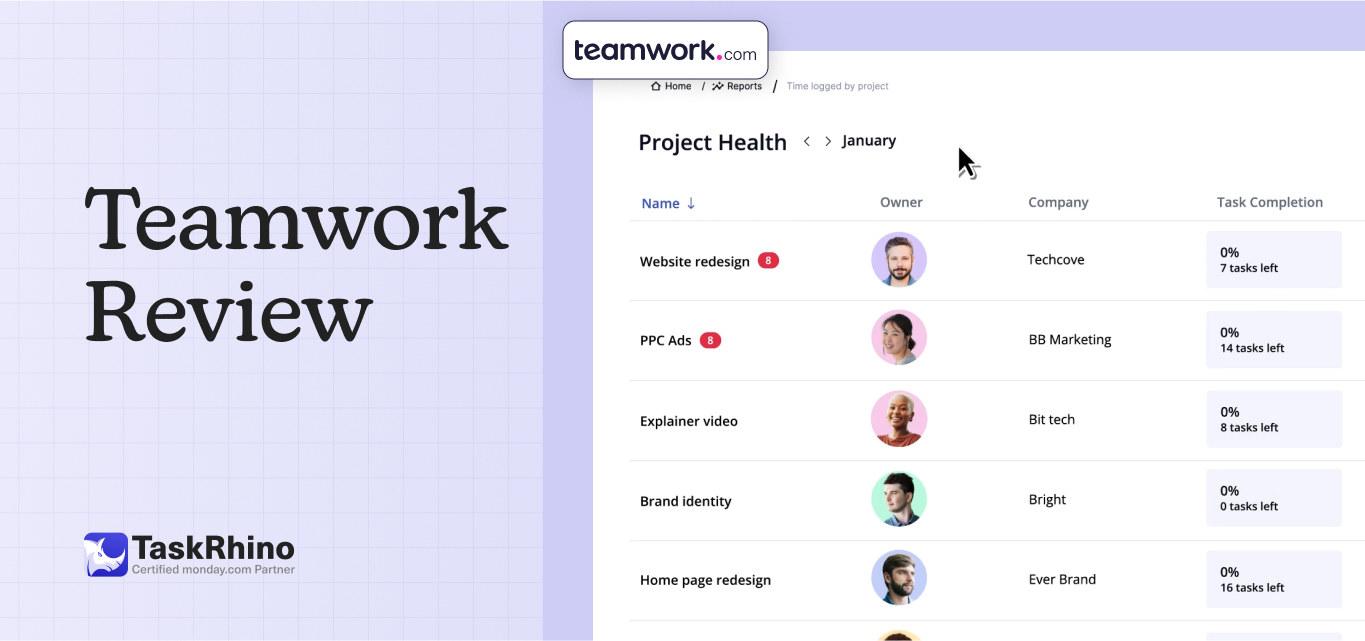
Teamwork Review: The Ultimate Tool for Efficient Project Management
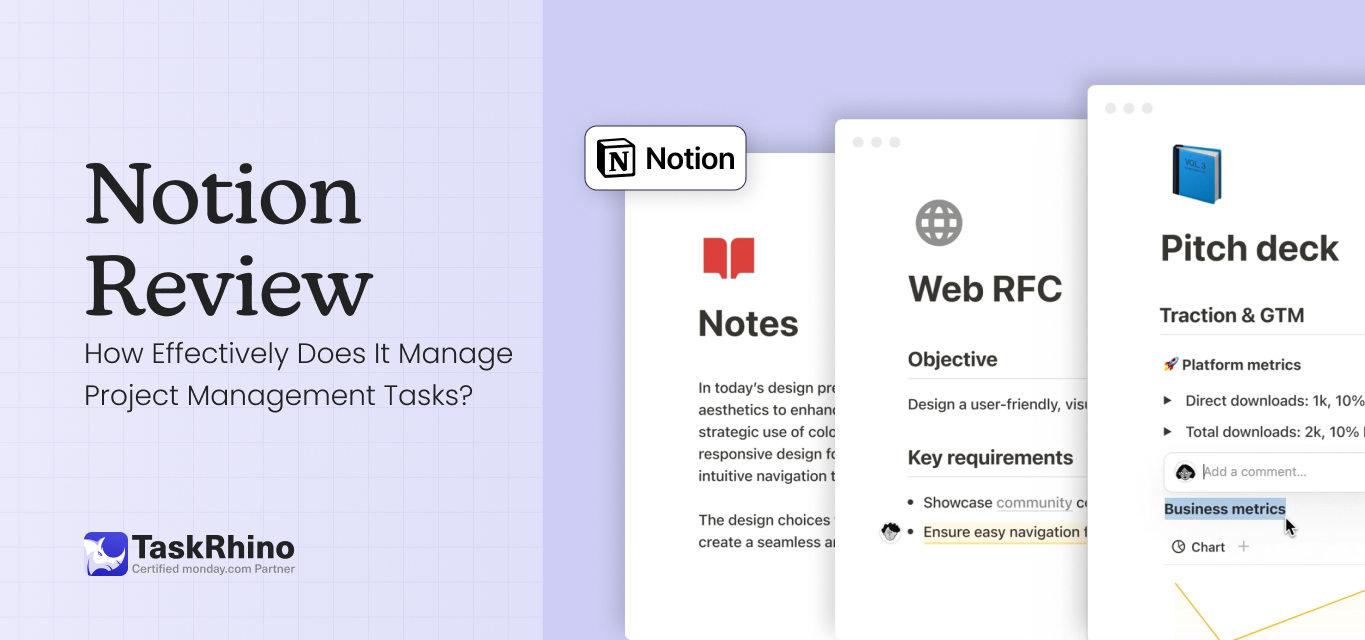
Notion Review: How Effectively Does It Manage Project Management Tasks?

Asana Review 2025: Complete Features, Pricing & User Experience Analysis
